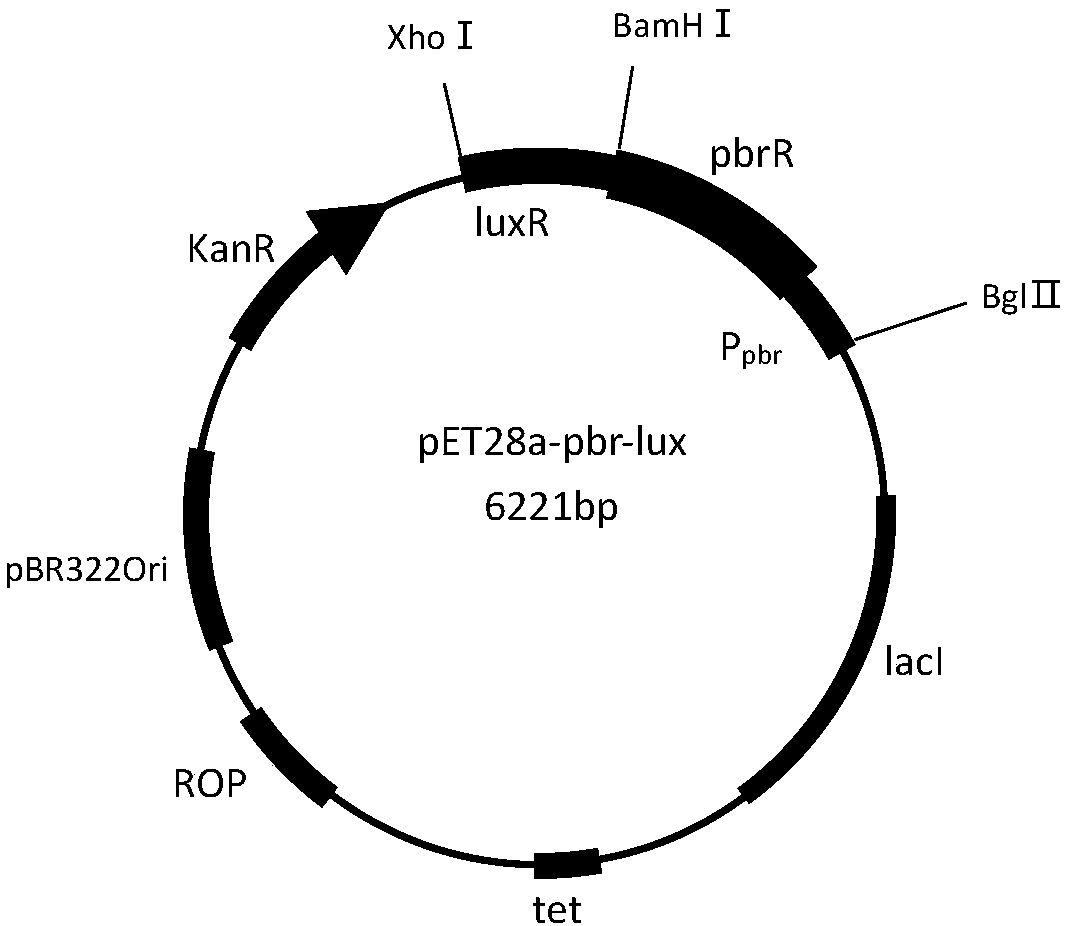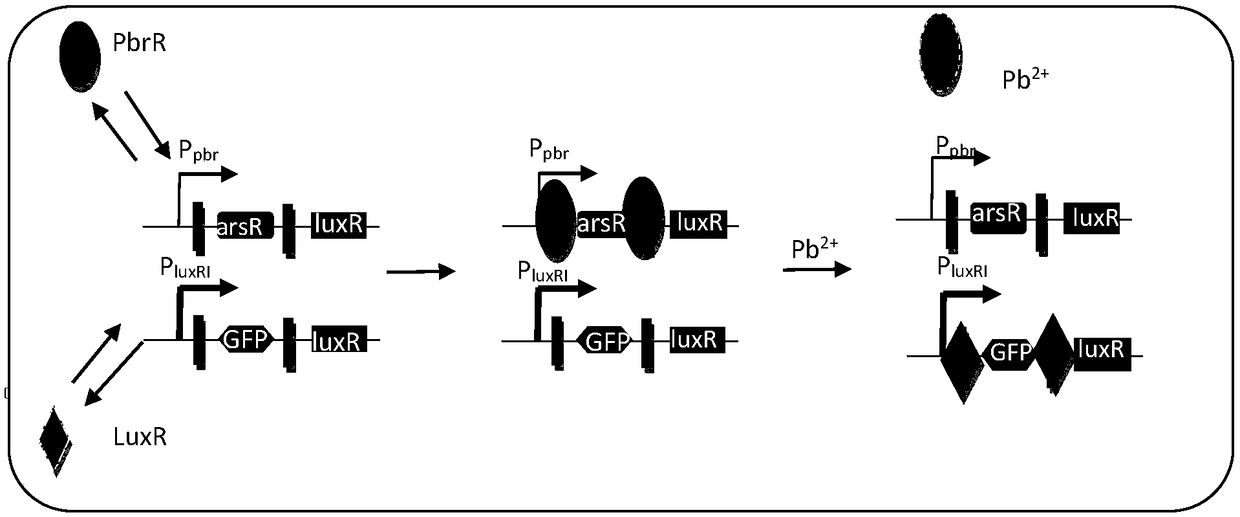Method for establishing lead ion sensitive whole-cell biosensor
A biosensor, lead ion technology, applied in microorganism-based methods, biochemical equipment and methods, microorganisms, etc., can solve the problems of high detection limit and low sensitivity, and achieve the effect of improving sensitivity and reducing detection background value.
- Summary
- Abstract
- Description
- Claims
- Application Information
AI Technical Summary
Problems solved by technology
Method used
Image
Examples
Embodiment 1
[0038] Example 1 Construction of recombinant expression vector pET28a-pbr-lux
[0039] Artificially synthesized lead ion-specific binding protein PbrR and bidirectional promoter P pbr , whose nucleotide sequence is shown in SEQ ID No.1; self-feedback regulatory protein LuxR, whose nucleotide sequence is shown in SEQ ID No.1. The nucleotide sequences shown in SEQ ID No.1 and SEQ ID No.4 were connected by enzyme-cut ligation, and the positive clones were screened to obtain the recombinant vector pET28a-pbr-lux. The plasmid map is shown in figure 1 shown.
[0040] The nucleotides shown in SEQ ID No.1 obtained through chemical total synthesis are respectively added with Bgl Ⅱ and BamH Ⅰ restriction sites at both ends of the fragment by PCR method, and FastDigest endonucleases Bgl Ⅱ and BamH Ⅰ are used for enzymatic digestion. Cutting, the reaction system is: 5 μL 10*FD buffer, 2.5 μL BglⅡ, 2.5 μL BamH Ⅰ, 30 μL nucleotide shown in SEQ ID No.1 with enzyme cutting site and 10 μL ul...
Embodiment 2
[0041] The nucleotide shown in SEQ ID No.4 in pGN68 was added with BamH Ⅰ and Xho Ⅰ restriction sites at both ends of the fragment by PCR method, and it was ligated with FastDigest endonuclease BamH Ⅰ and Xho Ⅰ The expression vector pET28a-pbr of the nucleotide shown in SEQ ID No.1 is subjected to double digestion, and then the nucleotide shown in SEQ ID No.4 is connected to the nucleoside shown in SEQ ID No.1 by DNA ligase On the expression vector pET28a-pbr of the acid, the enzyme digestion ligation reaction system and reaction conditions are according to the construction method of the expression vector pET28a-pbr connected with the nucleotide shown in SEQ ID No.1. After enzyme digestion and ligation, the competent cells E.coli DH5α were transformed, and positive clones were screened by colony PCR to obtain the recombinant vector pET28a-pbr-lux, which was verified by sequencing. Construction of embodiment 2 plasmid pGN68
[0042] The green fluorescent protein gene GFP conta...
Embodiment 3
[0044] Example 3 Recombinant expression vector pET28a-pbr-lux and plasmid pGN68 were co-transformed into Escherichia coli chassis strain E.coli DH5α (see figure 2 ).
[0045] The detailed construction steps of recombinant expression vector pET28a-pbr-lux and plasmid pGN68 co-transformed into E. coli chassis strain E.coliDH5α are as follows:
[0046] 1. Inoculate 100 μL of activated E. coli strain DH5α in 10 ml of LB medium, culture at 37°C, 220 rpm, until OD 600 When the temperature is 0.5-0.6, transfer to a 10ml centrifuge tube, centrifuge at 4500rpm / min in a pre-cooled 4°C centrifuge for 5min, remove the supernatant, and collect the bacteria;
[0047] 2. Wash the bacteria with 5ml of pre-cooled sterilized 0.1mol / L calcium chloride, centrifuge at 4500rpm / min for 5min in a pre-cooled 4°C centrifuge, remove the supernatant, collect the bacteria, and wash twice Second-rate;
[0048] 3. Pour off the supernatant as much as possible, add 50 μL 0.1mol / L calcium chloride, and 50 ...
PUM
 Login to View More
Login to View More Abstract
Description
Claims
Application Information
 Login to View More
Login to View More - R&D
- Intellectual Property
- Life Sciences
- Materials
- Tech Scout
- Unparalleled Data Quality
- Higher Quality Content
- 60% Fewer Hallucinations
Browse by: Latest US Patents, China's latest patents, Technical Efficacy Thesaurus, Application Domain, Technology Topic, Popular Technical Reports.
© 2025 PatSnap. All rights reserved.Legal|Privacy policy|Modern Slavery Act Transparency Statement|Sitemap|About US| Contact US: help@patsnap.com



